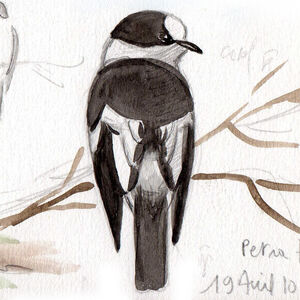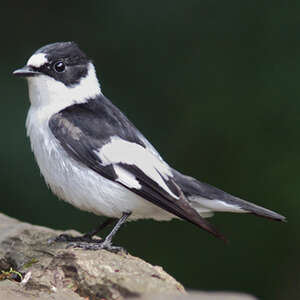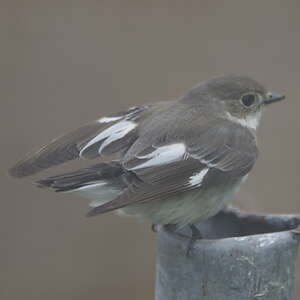Collared Flycatcher
Ficedula albicollis - Gobemouche à collier
Identification
The Collared Flycatcher is part of a group of 4 species of the genus Ficedula whose breeding male is bicolored, white and black. Two of them are nesters of the western Europe and in France, the Collared Flycatcher and the Black Flycatcher. Roughly speaking, on its breeding grounds, the male has black upper parts, with a white spot on the forehead and white markings on the wings, and its underparts contrasted white. However, the same is true for the male Black Flycatcher. Consequently, one must remain aware. Its song is already a very good initial clue. In addition, as its name implies, the Collared Flycatcher has a full white collar in continuity with its white throat. On the other hand, the Black Flycatcher only has an outline under the ear. At the back of the body, the male Collared Flycatcher shows a pale grey rump, clearly visible when the wings are moved and a fully black tail. Whereas, the male Black Flycatcher has a black rump and a white in its outermost rectrices, indiscernible while at rest. One must look out for its wing projection length, that is to say the tip thereof, a common characteristic of large migratory birds. Its bill and legs are black and its eyes dark brown. The second-year male has less defined, uniform and contrasted plumage.
Female identification is more complex as female Black or White Flycatchers are strikingly similar. Upper parts are brown with darker wings and tail, and white markings on the wings. The brown is tinged with grey on the female Collared Flycatcher, who has the largest white spot at the base of its outermost primaries. On the breeding grounds, with which males it is associated, it is the most convenient way to identify it. The locality, the habitat and its song will also help.The juvenile has the mottled plumage like other young flycatchers and strong white at the tip of the secondary coverts, at the base of the outer primaries and on the three outer rectrices.
Subspecific information monotypic species
Foreign names
- Gobemouche à collier,
- Papamoscas acollarado,
- papa-moscas-de-colar,
- Halsbandschnäpper,
- örvös légykapó,
- Withalsvliegenvanger,
- Balia dal collare,
- halsbandsflugsnappare,
- Halsbåndfluesnapper,
- muchárik bielokrký,
- lejsek bělokrký,
- Hvidhalset Fluesnapper,
- sepelsieppo,
- Withalsvlieëvanger,
- papamosques de collar,
- Trafgrípur,
- muchołówka białoszyja,
- baltkakla mušķērājs,
- belovrati muhar,
- Мухоловка-белошейка,
- シロエリヒタキ,
- 白领姬鹟,
- halsbandsflugsnappare,
- 白領姬鶲,
Voice song and call
The usual call on breeding grounds is a sharp and insistent hiiip that carries well. In cases of danger, one can hear tec or te tec sounds, like tongue clucks. The song is also quite distinctive and cannot be confused. It is made up of small, slightly grating phrases. A singing strophe is a succession of high sii with an irregular rhythm, alternating with various syllables, some fluting, some impure, others reminiscent of calls, all of which, in combination with the forested look, make it a typical Collared Flycatcher.
Habitat
Unlike its black counterpart which inhabits mixed woodlands, the Collared Flycatcher is closely linked to deciduous woods on its breeding grounds.
In its southern African wintering area, it appreciates Brachystegia woodlands between 800 and 1600 meters in altitude.
Behaviour character trait
If it weren't for its typical calls, the Collared Flycatcher is a bird that would go unnoticed in the heart of old forests.
Even when spotted, its observation is not easy in the shadowy light of the leafy foliage and requires patience, especially because the bird is quite shy. There's no chance to see it better during migration as, like a good flycatcher, it migrates at night and thus escapes observation. We may hope to see it during its diurnal stops, and even then, it's only far away from us since its long wings enables it to take long migratory steps.Flight
The Collared Flycatcher is well-equipped for flight. It has long wings that allow for long migratory journeys. On its breeding grounds, the priority is to hunt flying insects in the leafy foliage. This is also facilitated by the long wings which allow it to avoid branches, and of course a very good vision for precise prey spotting.
Dietfeeding habits
Essentially insectivorous, but not exclusively. A few small berries can be included in the diet outside breeding season.
In its breeding sites, it hunts for insects in the tree canopy, that is, in the upper part of the wooded area. It can capture its prey both in flight and resting. For instance, for butterflies or moths, adult forms are mainly taken on the wing while caterpillars are obviously taken resting.
The bird samples among the potential prey which are insects, arachnids, myriapods, and even some small mollusks. In case of an outbreak of foliage-eating insects, of course, the Collared Flycatcher will turn to them and feed its young.
Reproduction nesting
When the adults arrive in late April in Northeastern France, they quickly settle onto the breeding grounds.
The male birds sing actively near a cavity in an effort to attract a female and keep her. Nesting follows shortly thereafter. The nest is constructed of leaves and lined with plant fibers. The female typically lays 5-7 pale blue eggs without spots which are incubated for 12-14 days before the hatchlings enter the world. They remain in the nest, being fed by the adults for at least 15 days.Reproductive success can be hindered by predation from a Eurasian Green Woodpecker on the eggs or hatchlings, as well as by the Wild Marten or a rodent like the European mole. After leaving the nest, the young rely on the adults for another week before becoming independent. After this point, it becomes difficult to observe the species since there is only a single breeding event. The adults no longer are held by a territory and become wanderers of the forest. It is impossible to know when they leave for their migratory journey, as this event surpasses observation.
Geographic range
The Collared Flycatcher breeds in central Europe, from northeast France and southern Germany to the southeast of Russia and Ukraine to the east. It is found in northern Sweden to the north and northern Italy and Macedonia to the south. Migration mostly takes place east of the Mediterranean. The main wintering area is in southeast Africa (Malawi, Zambia, Zimbabwe).
Threats - protection
IUCN conservation status
concern
in the Wild
threatened
evaluated
Climate change in Europe is likely to have an effect on species such as the Collared Flycatcher. In particular, its impact on insect life must be taken into account. In the case of Lorraine, it must be closely monitored. Until now, the species has remained regular in its strongholds, particularly in the great state forests. But what does the future hold? An increase in the exploitation of mature oaks would obviously do the species harm.
Sources of information
- IOC World Bird List (v15.1), Gill, F and D Donsker (Eds). 2025-12-07.
Other sources of interest
 Specification sheet created on
26/07/2023 by Jean François
Specification sheet created on
26/07/2023 by Jean FrançoisTranslation by AI Oiseaux.net
© 1996-2025 Oiseaux.net
- Accipitriformes
- Aegotheliformes
- Anseriformes
- Apodiformes
- Apterygiformes
- Bucerotiformes
- Caprimulgiformes
- Cariamiformes
- Casuariiformes
- Charadriiformes
- Ciconiiformes
- Coliiformes
- Columbiformes
- Coraciiformes
- Cuculiformes
- Eurypygiformes
- Falconiformes
- Galliformes
- Gaviiformes
- Gruiformes
- Leptosomiformes
- Mesitornithiformes
- Musophagiformes
- Nyctibiiformes
- Opisthocomiformes
- Otidiformes
- Passeriformes
- Pelecaniformes
- Phaethontiformes
- Phoenicopteriformes
- Piciformes
- Podargiformes
- Podicipediformes
- Procellariiformes
- Psittaciformes
- Pterocliformes
- Rheiformes
- Sphenisciformes
- Steatornithiformes
- Strigiformes
- Struthioniformes
- Suliformes
- Tinamiformes
- Trogoniformes
































